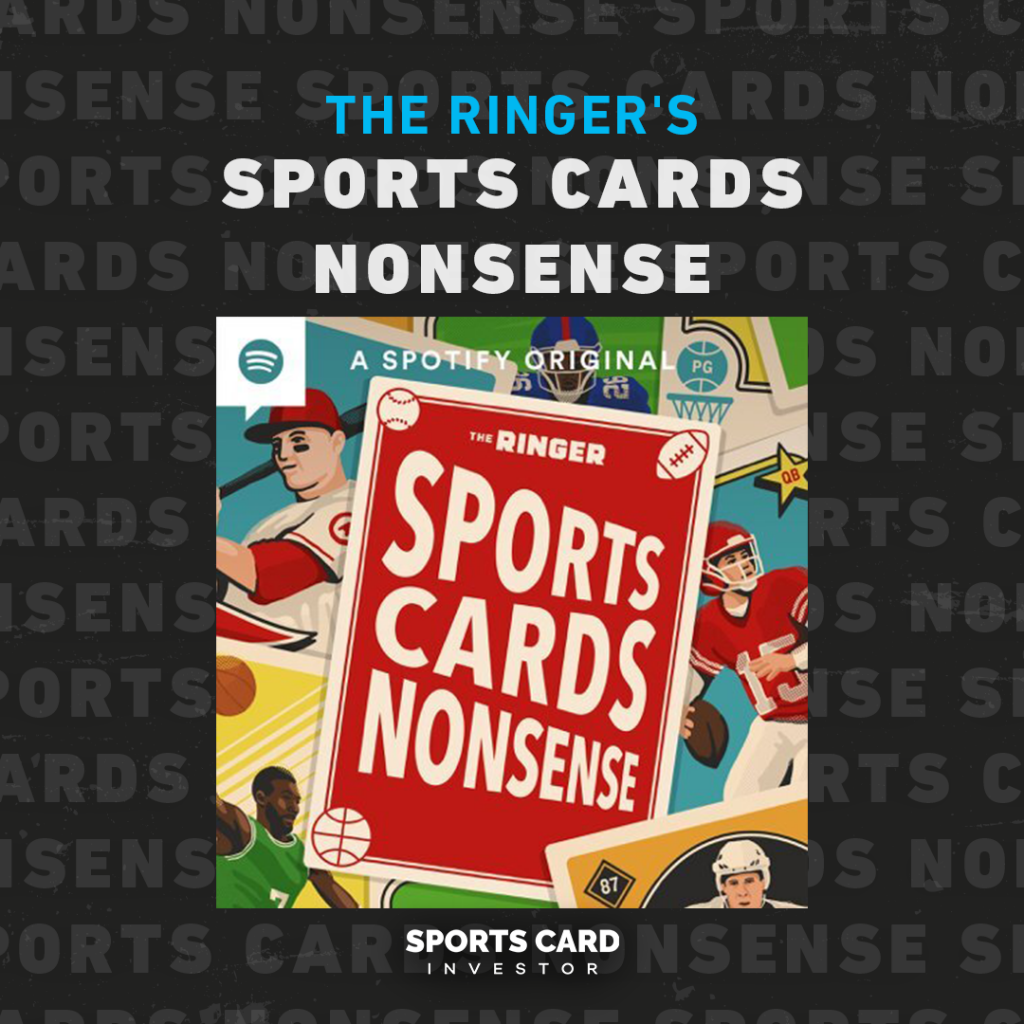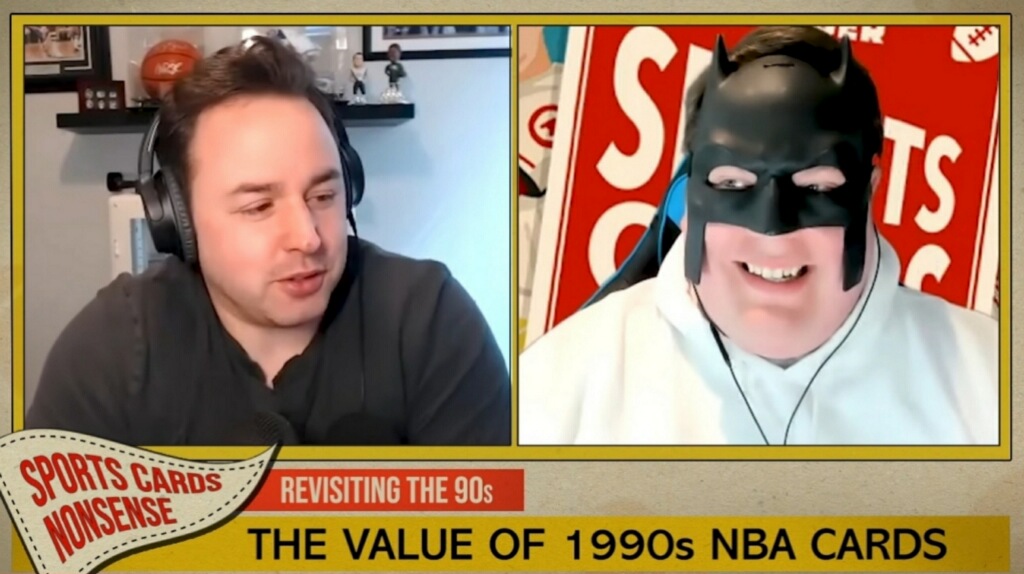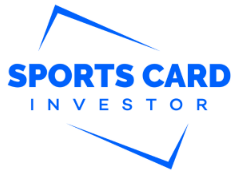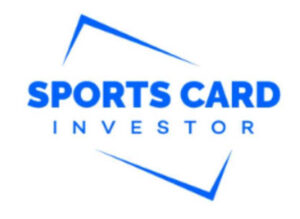
Meet the Dynamic Duo Behind The Ringer’s Sports Cards Nonsense
Like many great projects, the Sports Cards Nonsense podcast was started out of spite.
Mike Gioseffi watched the sports card hobby bring in millions of new collectors as it exploded in popularity over the last few years. But with those new collectors came the podcasts. And the YouTube channels. And the Instagram accounts.
According to Gioseffi, most of them were terrible.
“I thought there’s just so many hacks in the space and there’s not one voice out there of somebody actually in it,” Gioseffi says.
Gioseffi took it upon himself to change that. What started as him talking into the void that is Facebook Live quickly turned into a podcast. Then came Jesse Gibson, first as an editor then as a co-host.
“I just saw a lot of people doing it and thought we could do it better,” Gioseffi adds.
A few episodes, some TikToks, and a Twitter direct message later and Gioseffi was on the phone with The Ringer’s Bill Simmons talking about a deal. They insisted the format and content wouldn’t change and, about a month later, the Spotify contract was signed.
Mostly sports but always nonsense, episodes drop every Tuesday and Friday.
Sports Card Investor checked in with Gibson and Gioseffi to talk about SCN’s creation, NFTs, what they’re collecting and more.
Questions and answers were edited for length and clarity.
How did this relationship get started? How did you two meet?
Gibson: He pursued me. We are family, so he is married to my cousin — we met, what, like 12, 13 years ago? Something like that. Whenever (Mike and his wife) got married, a little before that we found that we enjoy each other’s company to the point that we can stand being around each other for more than 10 minutes. So now we’re friends and now we hang out all the time.
How did the podcast get started? Mike, you’re a big card guy but Jesse isn’t.
Gioseffi: I sold my breaking company back in August and just stayed on as a consultant and I just had a lot of time. I have one company –– one account where I’m just a consultant and I started a real estate thing that took off, so my money was set up. I thought there’s just so many hacks in the space and there’s not one voice out there of somebody actually in it.
In all the podcasts, with all the YouTube guys, I don’t know any of these people and I’ve been in this thing for 10 years and I’ve never seen any of them in it because none of these are card guys. I was like, “Man, it’s amazing all the people dishing out advice who have never been involved in this.” I just thought it would be nice to have somebody who actually is on the ground in this hobby talking to people in the hobby.
I do a lot of this out of spite. I just saw a lot of people doing it and thought we could do it better.
Gibson: It’s just another spite company. So where that starts is Mike wanted to do something kind of like what he was doing on Facebook Live, where he talks to the audience for like 30 minutes. Then it kind of went “Well, we should do this as more of a regular thing” and I wasn’t even part of it when it started out.
Mike had another partner and I was just editing the podcast. When that guy didn’t have as much time, I kind of stepped in. And the dynamic kind of changed to where we know a lot of guys are new to this industry. A lot of guys don’t know what they don’t know and I’m one of them, and I could add a voice of “What are the questions I need to be asking jumping into this?”
Was it a legit strategy to have one guy in the know and another guy not so much?
Gioseffi: The people in this podcast space or sports cards space — none of these people talk like this when the cameras are off. There’s a lack of genuine personality in the space. People talk about cards and it’s very manufactured. I told Jesse, “I don’t need you to learn about the space. I don’t want you to learn about the space.”
Gibson: That was a big factor for me jumping in.
Gioseffi: That’s the thing. I said come in as you are — you don’t know anything, most of the people getting paid to do this don’t know anything. Just come in and be yourself and if it takes, it takes. And if it doesn’t, then fine.
You two go back and forth really well. Is that something you’ve built up over the years or was it something you had right away?
Gioseffi: I told (Bill) Simmons when he signed us, my only thing at the beginning is that I’m not doing a voice or a character. I’m a jerk to Jesse and he’s a jerk right back to me. Some people took it the wrong way but I honestly told him that if you were in a room with me and Jesse and we’re eating pizza with our family, this is the show.
Our rapport is what it is because it’s real and you can tell when it isn’t. And you could always tell when it’s radio people going back and forth. I wanted it to be just me and Jesse and there just happens to be a camera on.
Gibson: The difference between us and a lot of other people out there is that you have a company that hires two people that don’t know each other and then they’re supposed to have on-camera energy and make it work and this chemistry is supposed to happen. But we already have the chemistry and the response has been overwhelmingly positive. What we hear a lot is this is like a conversation I hear from my buddies at the bar if we’re just hanging out and I guess there’s an audience for that.

When did The Ringer get involved?
Gioseffi: Me and Jesse did maybe five shows together and we got a DM on Twitter from (The Ringer’s) Chris Vernon. I told Jesse someone is just screwing with us and I don’t do Twitter or Instagram so it seems silly. But at the time, Jesse explained he had a blue checkmark so it’s legit. He called me up that night and said you guys are great, the sports card market is exploding and I want to get you guys in touch with my boss.
Bill called me that night and, within a month of that conversation, we set up meetings with executives at Spotify and signed the deal.
How did you get started collecting, Mike?
Gioseffi: Started with my dad and my older brother. I started to do a little bit of a side hustle leading up to high school. I would go to shows and kind of, you know, buy and flip and have fun with it just as a hobby. Once high school hit, I kind of got out of it and took an 8- to 10-year layoff from the hobby. I was married for about a year or two and was just like, “I have a little bit of free money. It would be kind of fun to get back into something for fun.” Back then it was 2012.
In 2015 I was shipping stuff for this guy and saw that he lived a mile from me, so I went to drop off his card and he was a breaker, which was the first time I really heard the term. So he needed help, needed some financial backing and he was getting ready to break off on his own. Just needed a business partner to do the numbers and crap and that’s what got me back into it with a view to make money out of it.
What’s your collection look like? Is it cards you want to flip or mostly PC items?
Gioseffi: The PC side for me is still monetarily the most valuable. I was a huge Brady guy for years and I’ve just held onto that stuff through all those years. Gem rookies even, super nice autographs from back when Topps was still making those. Mostly Boston-based stuff. Brady financially is definitely the biggest. Bill Russell rookie, which is huge now. Larry Bird stuff. The only thing that’s in there that’s not really Boston-based is (Ken) Griffey Jr. I’ve got some old school, high-end Griffey cards.
The investment side, I’m really big into Kevin Durant and Ja Morant. Those are my two. And then I just have a box with anything else. Anything that’s in season and relevant I’ll buy if it’s under comps.

What’s your favorite big-ticket item in your PC and what’s a smaller item you really love?
Gioseffi: Big-ticket item is the Bill Russell rookie. That’s a card I had chased because back in the day, $1,000 on a card — I grew up with no money in Boston — was unbelievable. So, that was one of the first big cards. I spent $1,600 on that. At the time, for me, that was massive and now it’s one of the most valuable cards I have.
I always had a thing that if I pulled a Brady auto (while breaking), I would do anything I could do buy it from the guy. We didn’t break a lot of football. We were almost exclusively baseball breakers. I pulled two Brady autos. One was from Absolute. I bought it for $800. It’s probably worth $1,500 but I’ve always kept it because I thought it was cool. I pulled it. The other was a Flawless Brady auto /5. I pulled the card for a guy and he would not sell it to me, which was fine. So, I went on eBay and bought the same card and then we both got them graded and they both Gemed. I asked him if we could trade and kind of lost touch. I said, “Dude, I’ll give you $100. It’s the same card and same grade.” That I have as my fake I-pulled-this-card-type thing.
What are your thoughts on breaking and what it means to the hobby right now? Does breaking drive up prices on wax?
Gioseffi: I think overall it’s a good thing for the hobby. It’s been huge to get the hobby to where it is now. Like anything else, there was a ton of money to be made. Five years ago there wasn’t when we got into it. But all of a sudden, if you can get these cases at allocation cost, you can make 10, 20, 30 times if you hold it or break it for the current rate.
If you ask people why are wax prices so high? Oh, it’s because breakers are selling it for that. Well, in 2016, when I started breaking and wax prices weren’t high, I couldn’t sell it for that. So, where’s the connection? The connection is the market. The market dictates that Prizm is $2,000 a box and, yeah, I can get it for $300 a box. It’s like telling someone who bought Bitcoin for $600 last year, and it’s worth $60,000, (that) you should be a good guy and sell it for $1,000. Why?
There’s a balance there, too. Plenty of people come into the space and they bring nothing. They have no personality, their community is a joke and their shipping is terrible. They don’t handle cards properly, they don’t answer questions like they should. For guys like that, they are ruining it. But if the biggest argument is cost, I have no place for that. If people didn’t want to buy it for that, we would lower our prices.
Jesse, you’ve talked about getting involved with NFTs. Is that something you got into with NBA Top Shot? What are your overall thoughts on NFTs?
Gibson: My first venture into NFTs was Top Shot. Cryptocurrency is a different story. But that’s kind of what made me interested in Top Shot to begin with. NFT was still really new to me but I didn’t get what the appeal was.
It wasn’t really until I understood how you could make money on an NFT, even if it was the exact same as someone else’s. Once I got a better understanding of how they break it down, I thought maybe NFTs are something more substantial.
Bottomline is I think NFTs are really interesting in this hobby, but my concern is the bubble aspect to the NFT world because they got so big so fast. And I want to differentiate that between NFTs and the card market because I think the card market still has room to grow.
What about fractional assets?
Gibson: I like fractional more than I like NFTs just because, at the end of the day, there is a tangible asset and that asset isn’t as easily copied as a digital asset. I think for guys with a lot of money who really are passionate about this hobby they care more about the card than the electronic moment. I think especially for the cards like LeBron and Brady going for $2 million, these are cards that guys like and they wish they owned.
I think this is the only option for a lot of people, especially if you’re going to be adding new people to the hobby and you don’t want to create a new junk wax era. Your only option now is sort of “How do you make more of that without creating more of that” thing? I think fractional shares are a really good option, especially for your higher-end stuff.
Do you think these assets are especially susceptible to market drops because of lock-up periods?
Gibson: In this market? Absolutely. Because we saw the NBA stuff, anything from the 1990s and before they have had a boom this year. We had some of them in our Straight Cash Homie segment and some of them doubled from the time we said it over the next two or three weeks. Since then, some have come back down to where it was originally. So, what do you do in a situation where you buy a card and you think this was a great investment but you still can’t get your money for two more months and now it’s worth what it was originally?
Jesse, what have you been collecting or investing in lately?
Gibson: My thing has been more flipping. I don’t really have a personal collection because I’m more worried about getting some Jordan cards. Right now they are so heavily priced and I don’t want to get in at the higher price. My bigger investment right now is wax. I’ve got some sitting around that I’m hoping actually turns into money. My idea of investing in this is, as someone new to this hobby, I’m more risk conscious because I don’t have such a love for it. I have a love for making money off a good investment, but the fact that I don’t have a personal connection to any of the players or anything like that has taken off some blinders.
Mike, what do you think the biggest mistake people are making is?
Gioseffi: Panic. You see something is awesome so you buy in or you see someone get hurt so you sell. Overreaction, which is always good for people who are more level-headed. You can always make more money being level-headed. Just don’t panic. Relax and let things settle. I’d rather sell before the all-time high than sell and lose at the all-time low.
What’s a piece of advice you wish you had gotten when you were starting out?
Gioseffi: Patience. I wish someone told me to be patient. If I had my collection from 10 years ago, it would be worth like $4, 5, 6 million. It’s worth a fraction of that now, which is fine. And don’t be afraid to hold things because you like it. You don’t have to think something is up 20% that you have to sell. If you like it, hold it.






